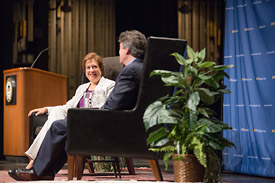Justice Elena Kagan offered a variety of professional and personal insights, drawn from her first two years on the U.S. Supreme Court, during an informal conversation with the Law School community Friday.
Topics ranged from whether public opinion and politics affect how justices function, to the impact of having three current female justices to the effect that oral arguments have on judicial decision-making.

Associate Justice Elena Kagan of the U.S. Supreme Court speaks with Law School Dean Evan Caminker during a presentation at the Power Center. Photo by Austin Thomason, Michigan Photography.
Kagan’s remarks, delivered to a nearly full Power Center, came in the form of a conversation with Law School Dean Evan Caminker. It was part of a weekend celebration to dedicate South Hall, the first new academic Law Quad building since 1934.
Kagan acknowledged the public scrutiny that has been focused on the court in light of recent high-profile 5-4 decisions, such as those involving the Affordable Care Act and corporate funding for political campaigns.
“I don’t think it makes much difference in the way we operate, if at all,” said Kagan, who was nominated by President Obama in 2010 to be the 112th justice. “Maybe all the people who are talking out there would be disappointed to hear that because they want everything that they’re saying to have some effect in the Supreme Court, but I think it doesn’t.”
She also addressed what some have suggested is a negative perception of the court as an institution. Part of that image may stem from 5-4 decisions — which actually make up a relatively small percentage of the 80 or so rulings the court issues each term — and the perception over the last couple years that her colleagues on the bench break along partisan lines.
“There is not a single member of this court, at a single time, who has made a decision, who has cast a vote, based on, ‘Do I like this president, do I not like this president? Do I like this piece of legislation that this particular Congress passed or do I not? Will this help the Democrats or will this help the Republicans?’ It is just not the way we think. It is just not the way any member of the court thinks in any case,” Kagan said.
But she acknowledged that justices do divide over substantive differences based on how they approach constitutional decision-making, methodology differences or different views about precedents that govern a case.
“So you can see why people think, ‘Well there are the conservatives and there are the liberals, and it’s just like the political world,’ even though it’s not like the political world. It’s really divisions about judicial method and constitutional decision-making,” she said.
Although much of the court’s work occurs in the form of written briefs and private discussions, Kagan said the oral presentations that attorneys make to the court can have an impact.
“I think it does matter. I don’t think it matters as much as the briefs,” she said. “You can sway people to your side or you can also lose a case in the oral arguments.”
Kagan said the fact that she is one of three female justices — the others are Sonia Sotomayor and Ruth Bader Ginsburg — doesn’t significantly impact how the court reaches its positions during closed-door conferences.
“I think it’s great that there are three women justices on the Supreme Court. I think it would be better if there were five women justices on the Supreme Court,” she said, drawing applause from the crowd.
However, “I don’t think I’ve seen a case where I’ve felt there’s something that the women are getting about the case that the men are not,” she said. “There’s no special great insight, and there’s no special style of decision-making, I don’t think, that goes along with gender.”
And despite philosophical differences, Kagan said, there are great friendships that bridge ideologies among the nine justices, a notable one being the liberal Ginsberg and conservative Antonin Scalia, who has called Ginsberg his “best friend.”
“It turns out we like each other quite a lot,” Kagan said. “I’ve been on a lot of institutions in my life and this is, I think in some ways, the most intimate and warmest institution I’ve ever participated in.”
Kagan’s talk was sprinkled with humorous asides, such as the description of her three formal duties as the least senior justice: answering the door during court conferences, taking notes during those meetings and serving on the court’s cafeteria committee.
“Literally, once a month I go to a meeting where we discuss the state of the chicken noodle soup,” she said. “I did introduce a frozen-yogurt machine to the cafeteria. … So, if I come to the end of my term and people ask if she did any one thing, at least there’s that.”

